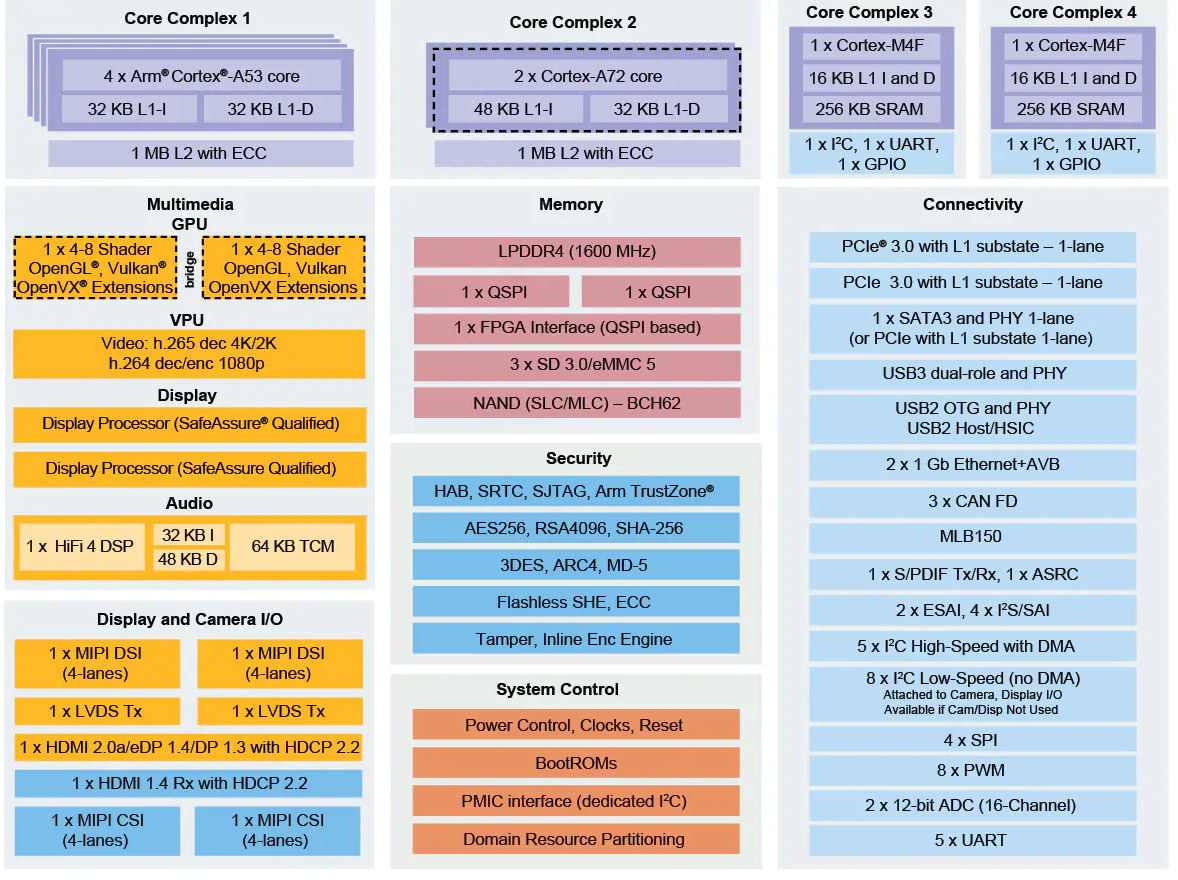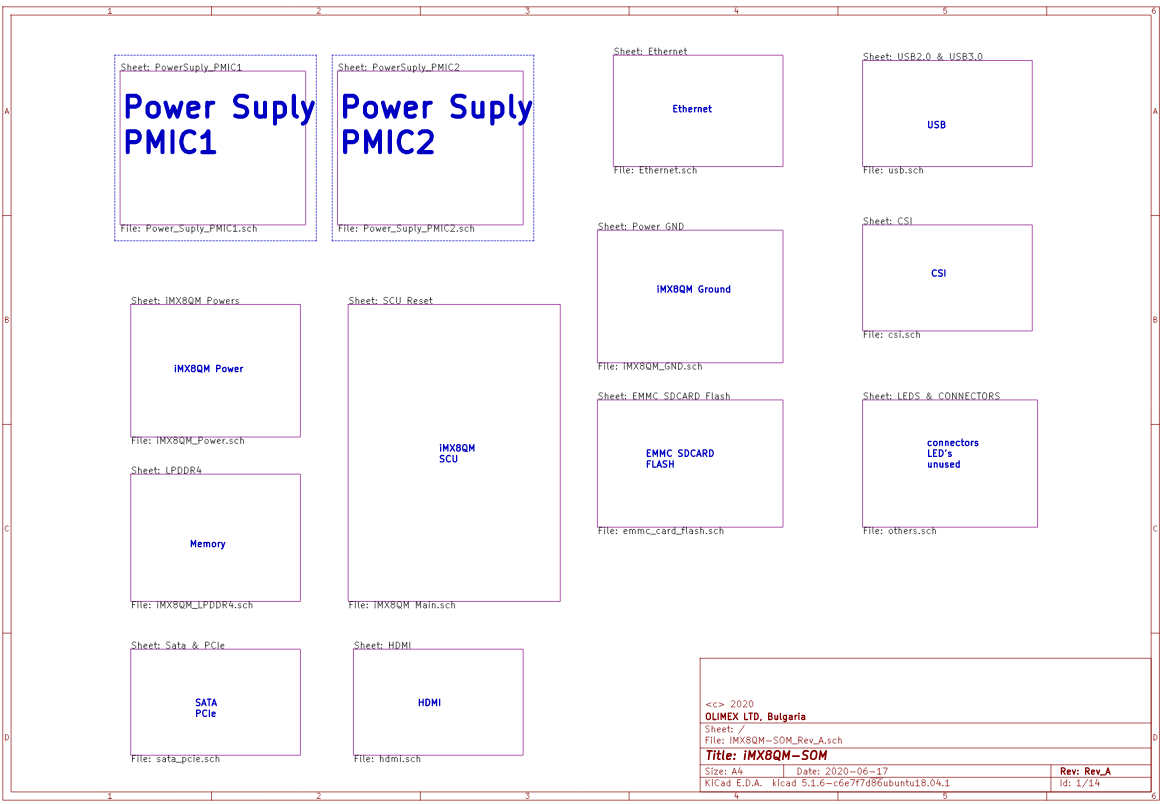[Update: The European company that initiated the project is Ignitial based in the west of France. So while we refer to the board as Olimex Tukhla in the post, it will be offered as Ignitial Tukhla once it becomes available]
Most open-source hardware Arm Linux SBCs are optimized for cost, and there are few higher-end boards with extensive connectivity designed for professionals. Beagleboard X15 would be one of the rare examples currently available on the market, but it was launched five years ago.
One European company noticed the void in this market and asked Olimex to develop a high-end open-source Linux board with a well-documented processor. They ruled out RK3399, and instead went Olimex Tukhla SBC will be powered by NXP i.MX 8QuadMax, the top processor of i.MX 8 family with two Cortex-A72 cores, four Cortex-A53 cores, and two real-time Cortex-M4F cores.
As you can see from the screenshot above, Olimex created the schematics in KiCad, and contrary to most (all?) other Cortex-A72 Arm Linux SBC from Korean or Chinese company who don’t usually release schematics (except PDF for some project), Olimex Tukhla will be fully open-source hardware with KiCad schematics eventually release (now only the PDF schematics are available at this time).
Preliminary specifications for Olimex Tukhla board:
- SoC – NXP MIMX8QM5AVUFFAB octa-core processor with dual-core Cortex-A72, quad-core Cortex-A53, dual-core Cortex-M4F, 4x GPUs with 16x Vec4-Shader GPU, 32 compute units, OpenGL ES 3.2 and Vulkan® support, 4K H.265 Decode, 1080p h.264 encode)
- System Memory – 2x LPDDR4 32-bit RAM up to 16GB of RAM
- Storage – eMMC flash of various capacity, QSPI flash, SATA port, 2x M.2 PCIe/NVMe sockets, MicroSD card slot
- Video I/O
- HDMI 2.0 output with HDCP 2.2 up to 4K resolutions
- HDMI 1.4 input with HDCP 2.2
- Camera I/F – 2x MIPI CSI camera connectors
- Networking – Dual Gigabit Ethernet
- USB – USB 2.0 OTG, USB 3.0 host
- Power Supply – 12V/4A

This is still very early in the design since they’ve only drawn the schematics for now (I took one month), and for such a complex board, development will take a lot of time to complete meaning it will likely only become available sometimes in 2021.
The board will also clearly target professionals who require an open-source hardware design, as Olimex explains the processor alone sells for around 100 Euros to which you need to add RAM and other components. That means the BoM (bill-of-materials) cost will be over 200 Euros, and retail price likely well over 300 Euros.

Jean-Luc started CNX Software in 2010 as a part-time endeavor, before quitting his job as a software engineering manager, and starting to write daily news, and reviews full time later in 2011.
Support CNX Software! Donate via cryptocurrencies, become a Patron on Patreon, or purchase goods on Amazon or Aliexpress. We also use affiliate links in articles to earn commissions if you make a purchase after clicking on those links.






€300 is a good price for a board at this level. Similar boards are in the market for €500 Euro.
There’s always rpi if one needs open hardware with open gpu drivers, no?
Where are the schematics? The gerbers? The CAE data? The datasheets and register manuals? Why an rpi can’t run an upstream kernel without any degradation? And last where is the openhw certification?
And there always the minor inconvenience that Broadcom won’t sell you the SOC in less than quantity one million.
Oh come on let’s not get into the details!
Fun name for SBC – translated from Bulgarian(Olimex is Bulgarian company) to English this mean “brick”. Anyway- they provide really well documented open source products. .
This could indeed make a nice general purpose board, and I agree that high-end chips are missing a lot on SBCs. Considering that RPi4 now plays well above the average board while it used to be the worst one could find makes me wonder what other manufacturers have been doing for that long, probably just selling STBs where only price and codecs matter.
With this said, at $100 for the SoC alone, I’m wondering if many professionals won’t prefer to go the x86 route instead; it requires much less effort to install and maintain than having to deal with a BSP or at least implement and maintain special boot and upgrade methods. And we’re speaking about only 2 A72 and 4 A53, something that is on par with the performance one can get out of the Atom X5 Z8350 you find on the original UP board. For a number of products, the performance per dollar really counts.
Where do you get an x86 with a longevity statement? Long therm supply agreements with intel are hardly 3 years nowadays it makes the impression on me. Maybe I’m wrong?
But nowadays arm has taken over a great deal of industrial design wins.
Most common embedded/industrial device manufacturers such as Kontron, Jetway, Acrosser, Commell, Nexcom, Axiomtek, will always give you a longevity statement, and will even accept or refuse certain parts depending on how long you need.
For me it’s even the other way around: if you buy x86 you have chances that it represents a high enough volume for the manufacturer for the model to last, and in the worst case if your CPU would be EOLed there would be a pin-compatible alternative available fitting the same socket. I’m not sure that many ARM-based manufacturer can engage on longevity, unless they’re using reliable chip makers like NXP. But for most others, you hardly know if they’ll remain in business the next year. Atmel and Cavium were acquired. Apparently the transition was smooth, but this is typically the situation where you could expect some products to be instantly cancelled.